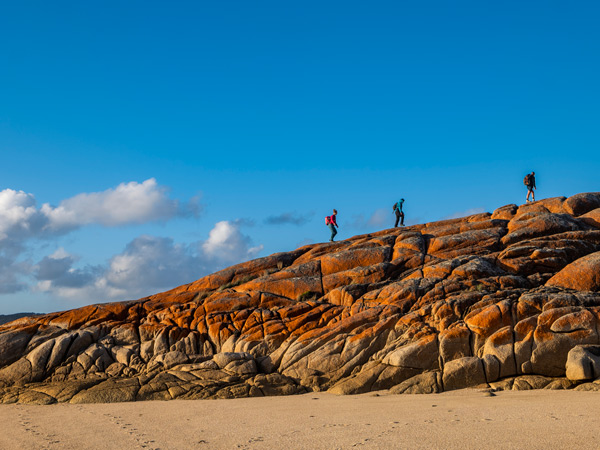Leading hikers between the rugged heights and coastal delights of Tassie’s Flinders Island, the latest Great Walk of Australia is an exercise in untamed beauty and human connection.
I shimmy my way through two oversized granite boulders, my backpack scraping as I go. I’ve been rock-hopping for more than an hour, but the colours make me forget myself; tangerine- and mint-splattered granite outcrops meet glass-like waters that reflect shades of blue, as black-pied oystercatchers pace the shore.
Traverse the rugged granite peaks for 360-degree views of Flinders Island. (Image: Lachlan Gardiner)
It’s the third day of a small-group walking holiday with Tasmanian Expeditions on Flinders Island, one of 52 in the Furneaux group of islands scattered across Bass Strait, north-east of mainland Tasmania.
We’ve spent the first half of the day summiting Mt Killiecrankie, which, at 316 metres above sea level, is the highest peak on the northern end of the island. Mt Strzelecki, the highest peak of the whole island, still awaits us. The 12-kilometre hike descends through Diamond Gully to Stackys Bight, a secluded bay with crystal-clear waters and a rock formation eroded into an archway that you can swim under at high tide. Sinking into the cool waters revives us for the final stretch of the day’s journey.
The glittering Killiekrankie Bay is awe-striking. (Image: Tourism Tasmania/Luke Tscharke)
The sense of something great
The day-pack-only guided walk covers 42 kilometres of easy-to-moderate hikes over the course of six days. I came here solo, like a handful of others in the group, but there are also two married couples, a father and son, and friends who met on a previous hiking trip. What they don’t know is that this multi-day hike is about to be inducted into the Great Walks of Australia collection – the first new addition in seven years and the 13th to be awarded the honour.
The diverse landscape includes rocky outcrops coloured by a mix of minerals. (Image: Lachlan Gardiner)
Great Walks of Australia launched with six founding multi-day hike experiences in 2013 and has since grown to become one of Australia’s most trusted walking experience brands. Small, intimate groups, comfortable accommodation, outstanding food and wine, and remote locations are all consistent features across the portfolio.
Sleep under a velvety blanket of stars at the Eco-Comfort Camp. (Image: Lachlan Gardiner)
I ask Nigel Heath, our lead Tasmanian Expedition guide, what makes this walking holiday worthy of the title. “All the great walks have a uniqueness [to them] – different parts of Australia, different geology, different history. [And] this being the only one on Flinders and particularly [because it’s] in Bass Strait, I think it really has something unique to offer. You’ve got a great combination of the mountains and the sea, the beaches and granite rocks. It’s a place that is hard to get to and not many people get to experience it. You get a really good variation of walks over the week.”
See unique native wildlife such as echidnas. (Image: Tourism Australia/Graham Freeman)
Its rugged and remote location is undoubtedly one of its draws. With few more than 1000 residents on the island, I count only a handful of times we run into another soul.
Tasmania’s original walking tour operator has crafted a rewarding itinerary. (Image: Lachlan Gardiner)
A calling for connection
With the rock-hopping behind me, I fall into line behind Catherine, a maths teacher here with her husband Michael, an engineer. Unlike me, the couple have a handful of walking holidays under their belt. I ask her what it is about this type of trip that keeps luring her back.
“My life is so comfortable, and I think I just want to push myself outside my comfort zone. Do something hard.” She doesn’t fit the mould of a multi-day hiker. The group has spent the past few days ribbing her in jest over her pristine hiking gear – mostly shades of lemon, white and pale blue. Her husband jokes that she packed a solar-powered iron.
Step into an awe-inspiring world of sparkling beaches, rugged ranges, abundant wildlife, flora and sapphire seas on Flinders Island.
You’d expect the elemental nature of the trip to wear on her at times, but she’s easily the most positive person in the group. “I come with the attitude of not complaining – I don’t want to be the one who brings the group down,” she adds.
They organised this trip with Vanessa and Paul, a Sydney couple who they met on a previous walking holiday. Serendipity landed them on the same trip a second time before they decided to take the hint and book this one together.
Bonds form easily on the trails. Conversations flit between favourite restaurants and new jobs, raising kids and overseas travels, but we also wade into deeper waters: the sharing of heartbreak and healing. It’s life in all its messy glory tumbling out with ease while crossing rivers, climbing mountains and hopping over rocks.
The camp is big on comfort but small on impact. (Image: Tourism Australia)
A truer telling of history
The pace slows on the fourth day and thoughts of connection and place turn to reflection as we stop outside a restored chapel on the west side of the island. “There’s a heaviness to this place that you feel the moment you enter,” says Andy Szollosi, the third of our Tasmanian Expeditions guides.
As we file into the chapel, I notice a poster printed with the words ‘This is a place of genocide’ above a photo of eight Aboriginal people waiting to return to their Traditional Country in Lutruwita. The walls are plastered with documents that unravel the dark history of this place.
On the opposite door is a sketch of chief Manalakina, of the Plangermaireener clan, one of the 134 Palawa who were convinced by George Augustus Robinson in 1834 to leave the mainland temporarily under his protection to join his so-called Friendly Mission at Wybalenna as colonists continued their attempt to erase Palawa from their own lands. Nearly all of them died on this site, looking beyond Bass Strait towards home.
Flinders Island is in the middle of Bass Strait. (Image: Tourism Tasmania/Luke Tscharke)
Treading lightly back at camp
A flock of Cape Barren geese take flight as we pass on our drive back to camp. Days start and end in the shadow of Mt Tanner at the beachside eco bush camp in Tanner Bay. The scent of Indian spices greets us on arrival. The second of our three guides, Clayton Hanlon, has been cooking a hearty vegetable curry in our absence.
Enjoy extra creature comforts on a Flinders Island Walking Adventure. (Image: Lachlan Gardiner)
The donkey – a boiler full of water heated by gas – is ready for the first of us to start showering. This nightly ritual consists of topping up the donkey shower with one bucket of cold water in exchange for one of hot water to be fed through a pump to the showerhead.
Each day ends at a scenic campsite in the remote wilderness. (Image: Lachlan Gardiner)
Dinner in the elevated al fresco camp kitchen and dining area is followed by deep-fried cottage cheese and ghee balls with sugar syrup for dessert.
The itinerary traces a path around The Dock, a rugged crag on a stunning patch of coastline. (Image: Tourism Tasmania/Alice Hansen)
I retreat to my tent as the sun starts to set, eager for rest. Others rush to the beach for one final dip before calling it a night. The see-through roof of my safari-style tent reveals an altogether different view to the one I’m used to back home: a blanket of stars fills the sky as I drift off to sleep.
The fully inclusive walking holiday with Tasmanian Expeditions includes dinner in a comfortable communal tent. (Image: Lachlan Gardiner)
The final summit
Mt Strzelecki stands 756 metres above sea level, nearly double Mount Killiecrankie; it’s fair to say there is a slight nervous energy as we gather at its base.
Rise at the first blush of sunrise. (Image: Daniel Tran)
Andy reminds us of the goal: “Come back alive, come back friends and maybe climb a mountain”. A saying he picked up from fellow mountaineer Mark Savage while filming Winter on the Blade, a documentary by Tasmanian filmmaker Simon Bischoff that follows the group as they attempt to ascend Tassie’s Blade Ridge on Federation Peak.
Spot the resident Flinders Island wombats. (Image: Tourism Australia)
A dense forest of casuarina trees marks the start of the hike. The climb is relentlessly uphill, but we pace ourselves, stopping often. Whitemark Beach comes into view in the distance after about a kilometre of hiking.
Embark on a walking holiday, boots and all. (Image: Lachlan Gardiner)
The landscape changes as we climb. Eucalypt trees give way to narrow trails lined with paper daisies that press in on us from all sides until rainforest delivers us to granite outcrops and the base of the Strzelecki Peaks. The final climb to the summit traces along a broad ridge of granite. The sense of achievement is even more rewarding than the view.
The walk offers immersion in nature. (Image: Tourism Tasmania/Adam Gibson)
Back at camp, the wine comes out, stories are shared and the inside jokes that always form on trips like these are passed around the tables. If it’s connection that’s calling you, walking holidays deliver.
Settle into island time around the fire. (Image: Lachlan Gardiner)
A traveller’s checklist
Getting there
Flinders Island is accessed via seaplane from Bridport, around an hour’s drive from Launceston.
Playing there
Tasmanian Expeditions offers an all-inclusive Flinders Island Walking Adventure In Comfort, a six-day and five-night, day-pack-only guided walk. The 13th Great Walk of Australia covers 42 kilometres of easy-to moderate hiking and includes a blend of sweeping coastal walks, crystal-clear swimming spots and rugged granite peaks to summit for 360-degree views of Flinders Island.
The 13th Great Walk of Australia comes with sweeping coastal walks. (Image: Lachlan Gardiner)
The post This six-day hike in Tasmania is Australia’s latest Great Walk appeared first on Australian Traveller.




